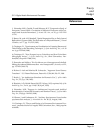
Page 45
CP-1 Digital Audio Environment Processor
room simulator has outputs for left, right, side and rear surround speakers.
The monaural input sound from the film is unchanged in the center
speaker, so that all the dialog and music that the director expected to come
from the screen still does, with no modification or reverb. Partly because of
the acoustical character of the room synthesizer, the result is often so
successful that switching from a monaural input with Mono Logic to a
stereo input with Pro Logic may make a surprisingly small difference.
The most critical adjustment in Mono Logic is the Effect Level. Ideally the
film’s music and effects should appear to come from the front but with the
added sense of a large space surrounding you. The side and rear speakers
should not be individually audible.
Theory
and
Design
Films originally have four channels:
one for dialog and three for music
and effects. To make a Dolby Stereo
film, these are combined to two.
During the early days of film ste-
reo, dialog was sometimes mixed
(by “panning” the monaural dia-
log track) to come from the same
part of the screen as the image of the
actor. Subjective reactions to this
technique were varied, and techni-
cal problems with some magnetic
sound tracks helped to discourage
the practice, so modern movies are
seldom mixed with panned dialog.
In a home system with a good Pro
Logic decoder, however, the effect
can work quite well; recent releases
with panned dialog include “Yel-
low Submarine” and “Superman
I”. In most films, though, all dialog
comes from the center channel.
Mono Logic works with the left input channel only. If it is used with a stereo
input, material recorded exclusively in the right channel will be ignored.
The CP-1 is one of a few consumer products to offer full Pro Logic Dolby
Surround decoding, and it is the only one that operates entirely in the digital
domain. This has important advantages, but to understand them we must
first take a brief look at how a film soundtrack is put together.
A Dolby Stereo film sound track has four basic components: Left and right
channels, a center front channel and a surround channel. The first three are
fed to speakers arrayed behind the movie screen, while the surround sound
goes to speakers on the side and rear walls of the theater. The four channels
are recorded on separate magnetic tracks and are combined by the Dolby
Stereo matrix encoder into two stereo channels during the final mixing
process. The original left and right channels go directly onto the left and
right channels of the Dolby Stereo mix. The center channel is fed equally to
both channels, in phase, and the surround track is fed equally to both
channels, but 180 degrees out of phase.
The center channel carries the dialog; music is normally mixed so that it
appears to come from the front, with reverberation or ambience coming
from the surrounds. For special effects, music can be encoded to come from
all around the listener or even from behind. In any case, with music and
ambient effects there is always substantial spread across the front of the
loudspeaker array.
Sound effects can come from any direction around the listener and it is the
job of the decoder to duplicate as closely as possible the film mixer’s
Pro Logic


















